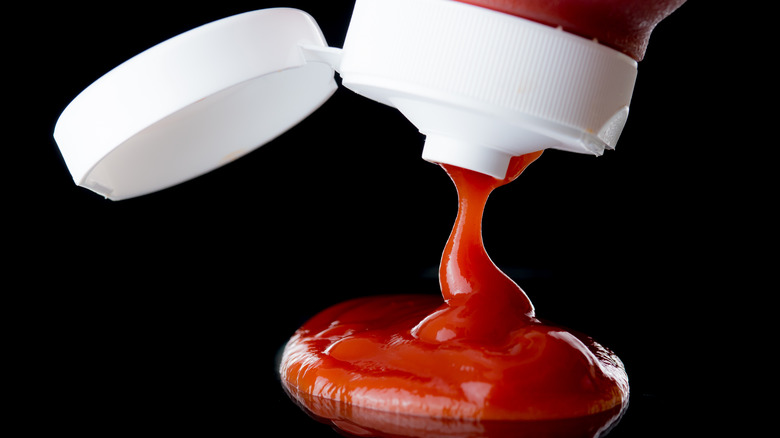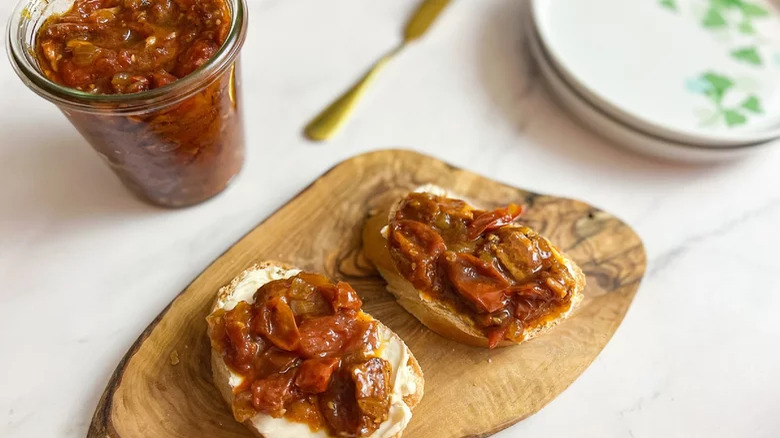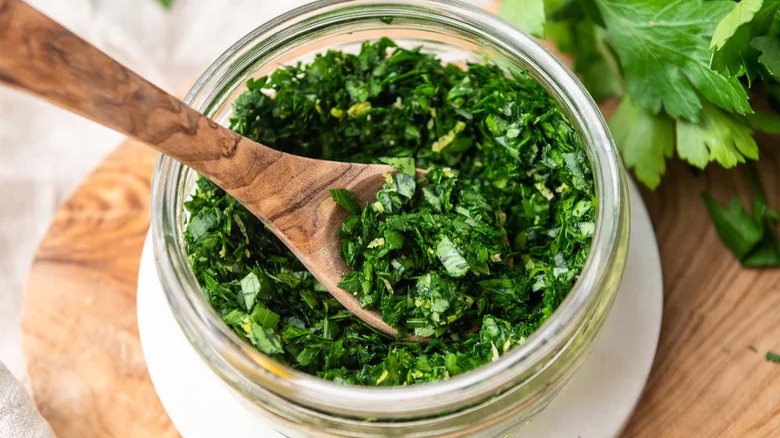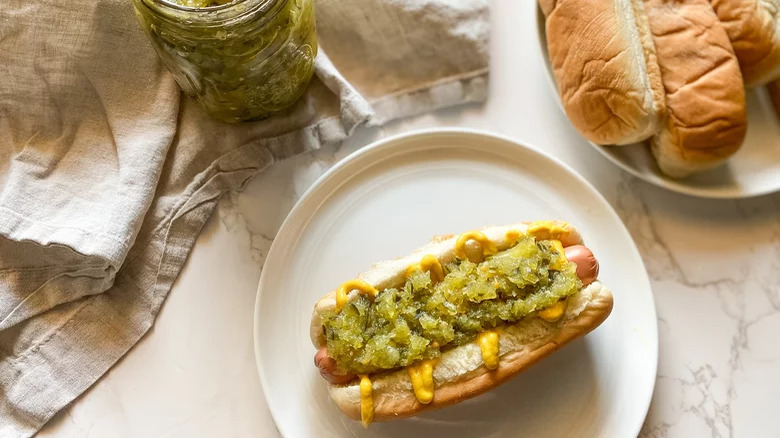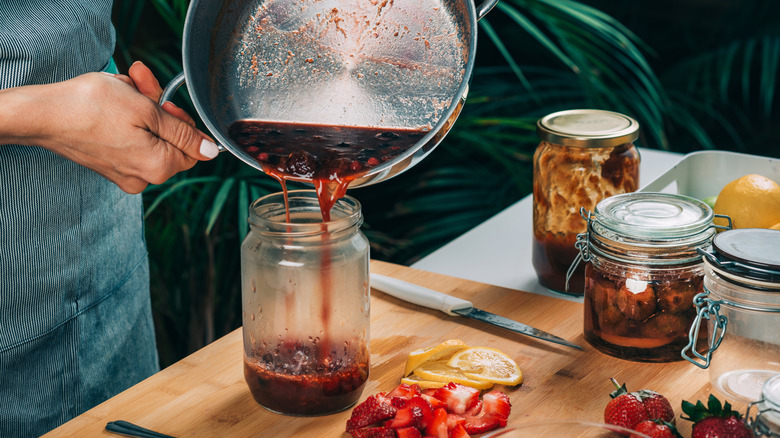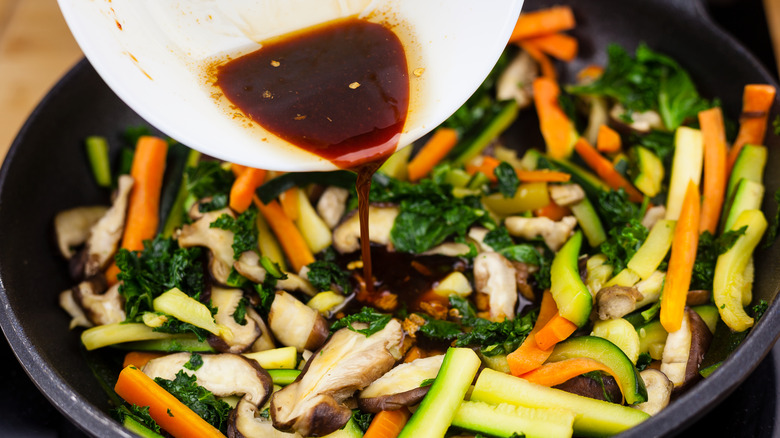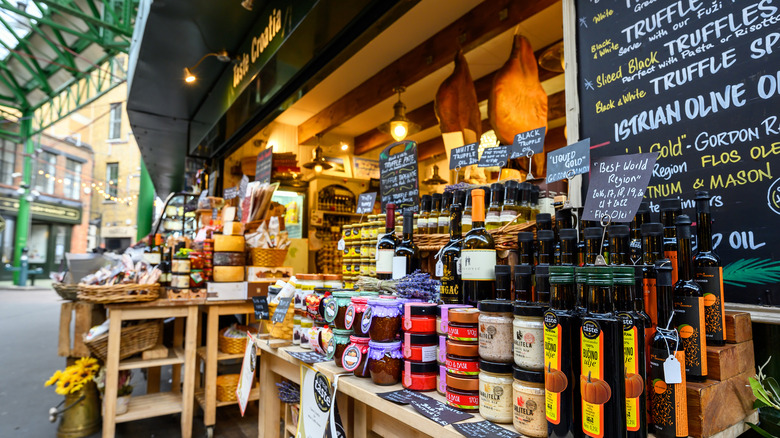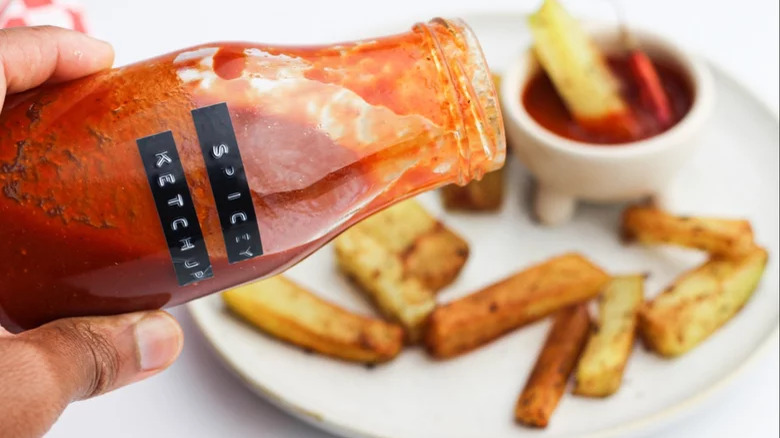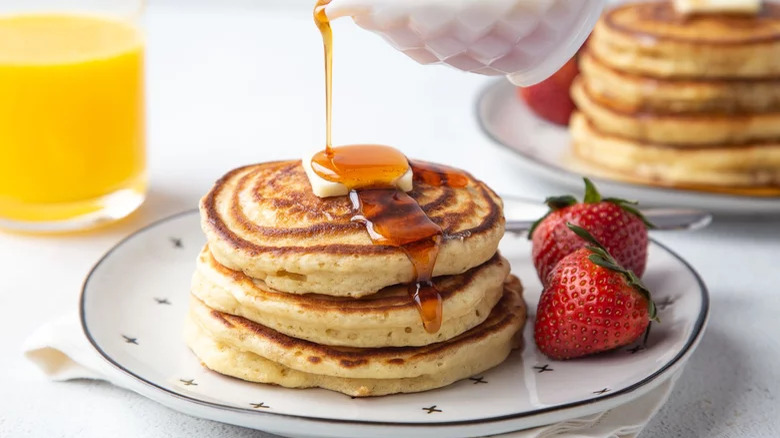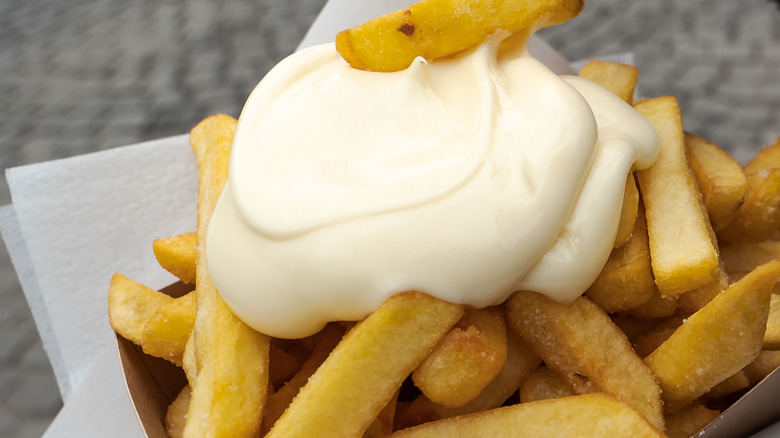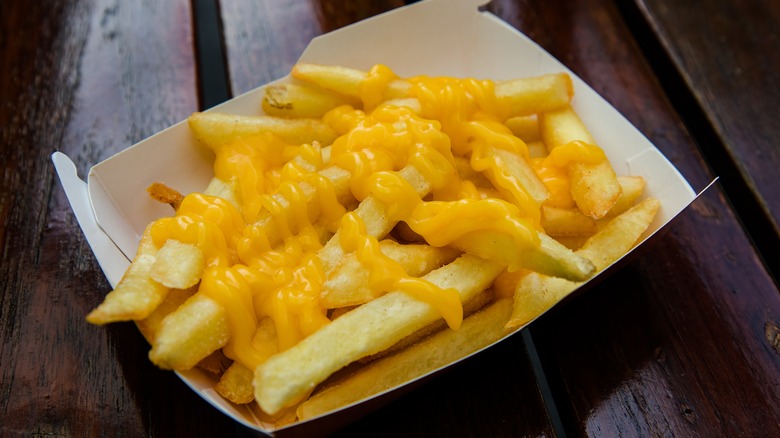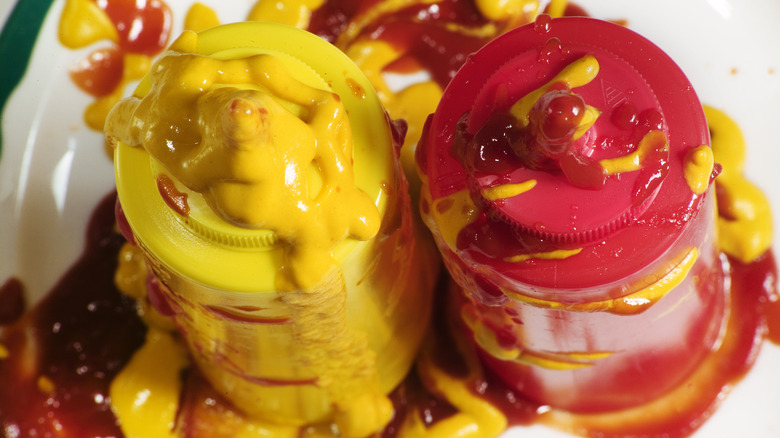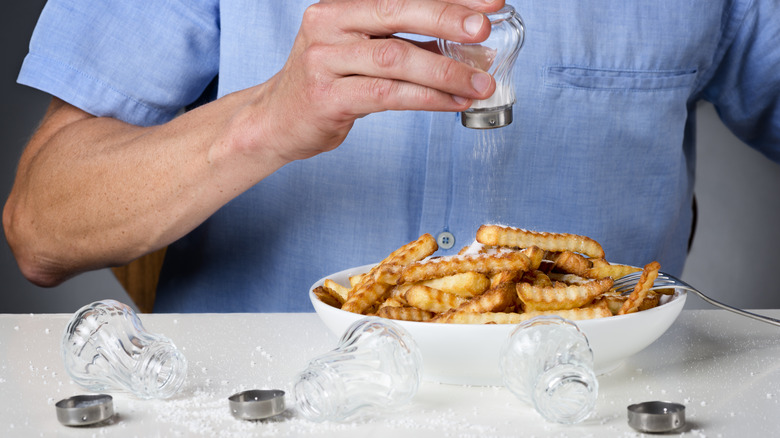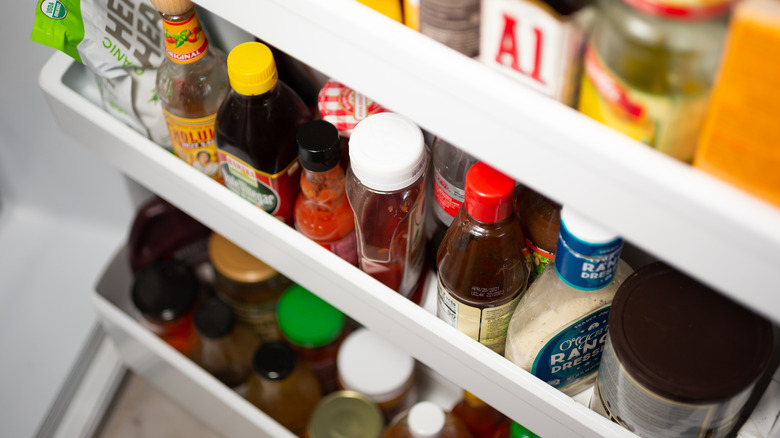Mistakes Everyone Makes With Condiments
Ketchup first appeared in 17th century England, and its name derives from Chinese. Meanwhile, while the Spanish have long been lovers of mayonnaise, French cooking brought it to the U.S. And mustard goes all the way back to when mustard seeds were also used to numb pain. Real wasabi was first used as a condiment in Japan over a thousand years ago. And barbeque sauce could have its culinary roots in Native American culture and Black slave communities in the South. Salt was likely the earliest condiment, with spices, chutneys, and vinegar to follow.
Condiments are much more than a footnote in the history of food and cultural heritage; in fact, they're pretty much a staple of human meal preparation throughout history. They promise a whole world of instant flavor and color, and so many dishes fall flat without them. Don't make the following mistakes everyone makes with condiments — properly celebrate them, instead.
Not using interesting condiments
Don't make the mistake of only adding the same-old-same-old, traditional condiments to your plate. Do you love culinary adventure and enjoy trying new flavors and ingredient combinations? If so, then it's time that you tried out some interesting condiments that aren't the standards you find just about everywhere. Tajín is amazing, while Japanese yuzu kosho also adds a hot, citrus blast. Gochujang is a fabulous Korean spicy condiment that's really on-trend, whereas nam jim gai is a Thai sweet chili sauce that's a moreish must with fried chicken. Cranberry mustard is sour and hot, making it ideal for serving with a charcuterie board. And what about some crunchy condiments such as air fryer chickpeas to give dishes a crispy appeal?
MSG, once banished by many, is regaining popularity, making it an interesting umami-rich contemporary condiment. If you're a fan of jellies and chutneys, then you might like the idea of tomato bacon jam. Try it on a grilled cheese sandwich; we assure you that you'll be glad you did. Instead of adding A1 sauce next time you chow down on a steak, what about a drizzle of homemade chili crisp? Add dried garlic, dried onion, and toasted sesame seeds to a spicy shallot oil for this recipe.
Not trying condiments from other countries
It's easy to imagine that ketchup and mustard are as ubiquitous in other parts of the world as they are in the U.S., but this isn't necessarily the case. There's a whole world of condiments from across the globe and different cuisines just waiting to be discovered. A mistake a whole lot of folks make with condiments is not exploring the seasonings, spices, and sauces from other countries.
In Spain, aioli is served with bread and olives before a meal to get the appetite going. And it's the perfect accompaniment to tapas such as calamari and croquettes. If you love the idea of a garlicky mayo-style condiment, then try roasted garlic aioli. What about a classic gremolata with herbs, garlic, and lemon? It adds a vibrant zing to traditional Italian fare such as ossobuco as well as pasta and bread. If you prefer a powerfully hot punch, then give a serious look at the kinds of hot mustard typically associated with Asian-style cuisine — those are perfect with crispy spring rolls and made from English mustard powder.
Never making your own
With additives, preservatives, and so many different ingredients, many store-bought condiments don't taste anything remotely like homemade versions. And since making your own condiments isn't really a huge task, it seems a shame to let down a brilliant home-cooked prime rib and not serve it with something like homemade creamy horseradish sauce. And if you like some surf with your turf, then homemade tartar sauce isn't that difficult to whip up, either. All you need is mayo to mix with onion, sweet relish, and maybe a little bit of shredded carrot.
Give ball-game fare a culinary glow-up with homemade hot dog relish made from green bell peppers, cucumber, and onion, plus seasoning goodies. Once you've heated all the ingredients on the stove, let the mixture cool before serving. You can store it for months, too, so be sure to make enough for the next sporting occasion after your team wins. Meanwhile, if you are going to the trouble of grilling homemade burgers at a cookout or making fried fish, why not try homemade ketchup, too?
Making your own condiments without following hygiene guidelines
If you are simply whipping up a little mayo with some sriracha, there aren't any extra food safety rules you need to follow. However, if you're making your own condiments to jar, then that's a different matter altogether. Not considering hygiene guidelines when making your own condiments is a mistake you don't want to make. If you make a zingy raspberry jam and want to prep jars, for example, you need to sterilize them. Washing them in hot, soapy water is a start, but not enough. They need to be made contamination-free by warming them up in a preheated oven set at 350 degrees Fahrenheit for 15 minutes. After that, you can also add hot jam to the jars without cracking them.
If you're making a fermented hot sauce, not sterilizing jars properly could prove to be an explosive mistake — quite literally. Bacteria can cause pressure to build up inside until the jar breaks. You could also end up with a moldy, inedible mess. When canning, simmer jars and lids in boiling water for 10 minutes, making sure they are completely covered. Leave them in the hot water until you are ready to use them. Meanwhile, when pickling, make sure that you add three parts vinegar to four parts water. This ensures that vegetables like cucumbers are stored in a sufficiently acidic solution.
Not using condiments in recipes
If you think serving condiments at the table is making full use of their potential, then you're wrong. Of course, it's fabulous to squirt some ketchup on top of a burger or add some sweet, spicy, and tangy chamoy to a fresh-fruit plate. However, only bringing in condiments when food is ready to serve is one of those mistakes pretty much everyone makes. It's best to think of condiments as ingredients that can also enhance dishes while you're in the process of making them; condiments are not for prepared food only.
You could try adding ketchup, for example, to stocks to create a richer, tomatoey base. A few splashes of a condiment in a vinaigrette can add an extra flavor. A dressing or dip can be creamy and hot, or it can be salty and sour if you add lime juice and fish sauce. Meanwhile, it's traditional to serve sushi with soy sauce, but what about adding it to a veggie stir-fry to lock in the flavor?
Not using gourmet condiments
If you are sitting down to a decadent dinner or a dish made with high-quality produce, adding a pinch of seasoning, a drizzle of oil, or a spoonful of spicy chutney can elevate the flavor. But never trying gourmet condiments is a very common mistake. Condiments made with special ingredients can transform a dish and upgrade an ordinary plate of food into a memorable meal.
Say you're enjoying some linguine. Could adding a glug of truffle oil transform it? If you find truffles irresistible, as many do, then this is surely going to beat a regular olive oil. Have you tried Maldon sea salt flakes or pink Himalayan salt? What about a handcrafted lemon relish or a balsamic vinegar made with dates? You might want to try condiments made from natural, organic ingredients or condiments sold by smaller companies. Sometimes at farmers markets — noted as terrific locations for finding independent, often locally made products — you can sample condiments before you buy them. Hot honey is on-trend, and you can also try spicy maple syrup next time you make pancakes. Meanwhile, fruit-infused ketchup is also a thing. What about a gourmet mayo designed especially to make your bagel taste better?
Not checking out new varieties of classics
Condiments like mustard and ketchup are everywhere. They are no doubt served at your dining table for weekday dinners and social events like cookouts. They are commonplace at food trucks, takeouts, local diners, and even al fresco bistros. Ketchup and mustard taste great, so it's obviously not a mistake to enjoy these traditional condiments — it is a mistake not to check out new varieties of these classic favorites.
Established brands such as Heinz have created a myriad of different types of ketchup. Some of these respond to dietary needs by reducing the usual levels of salt, sugar, and artificial sweeteners. You can even buy a Heinz ketchup that's made with carrots rather than tomatoes. One brand even makes ketchup without any tomatoes at all. There are different types of mustard, of course, from yellow English to dark-brown French, and grainy, vinegary Dijon. But what about a mustard that's made with bourbon and brown sugar? Or perhaps you like the idea of a hot sauce made with tequila? Mayonnaise has also been reimagined with spicy and savory flavorings to create a whole collection of new varieties of creamy condiments to try.
Pairing condiments with the wrong dishes
If you don't experiment with food, then how on Earth are you going to discover that hot sauce and ice cream are a thing? You probably shouldn't be super-quirky with your food-condiment matches all the time, though. A list of mistakes everyone makes with condiments would not be complete without highlighting the error of not pairing them with appropriate dishes.
Just as you pair sides and sauces with dishes, you can also choose condiments that complement the main flavor of a meal. Lamb chops are delicious with mint sauce, and in the U.K. a ploughman's lunch of cheese and a hunk of bread is only complete with a pickled relish or some pickled onions. Asian noodle dishes, on the other hand, fare better with some umami-boosting fish sauce. Mayonnaise-style condiments give sandwiches of all kinds a creamy taste and texture. And mustard, hot sauce, and ketchup are just what you need with grilled meats. There are also condiments specifically designed to be eaten with charcuterie boards, too, while lime marmalade and Asian plum preserves work well with a cheeseboard. Fig jam is yummy with salty cured meats and soft cheeses such as brie.
Getting too heavy on the mayo
Homemade mayonnaise is so good that you might be tempted to go overboard with how much you use. It can be a standout condiment, but it's not supposed to be the main flavor of any dish. Add it to your favorite sandwich with some salad, by all means; add a spoonful on fries instead of ketchup if you're a fan. But too much isn't good for your health and can ruin a dish. You might even want to go easy on store-bought mayo which contains additives and preservatives to make it last longer and make your own.
Mayo can be relatively high in sugar, fat, and calories, but loading a little on the side of a salad is fine. If you've added too much mayo to a potato salad or other ingredients, then you might want to scrape some off, or even wash it off. If that's not feasible, then adding oil can stop the mayo from being too thick and gloppy. Another option is tempering the creamy taste with some spices or adding some strong-flavored ingredients. You could also add more other ingredients that have a crunchier texture to balance out the sogginess of too much mayo.
Not being aware of health factors
Since a condiment is an add-on to a dish, you may not give it much consideration in terms of whether it's good for you. This is a mistake. You might choose a salad over a meaty burger due to the nutritional differences, so why not think about how high in salt, fat, and sugar a condiment is? Or how many ingredients are added that you'd rather avoid? You might want to hold back on the queso and cheese that comes from a bottle.
A vinaigrette or kimchi may have a lot of good fats and nutrients. However, store-bought barbeque sauce could be sweet because it's packed with sugar. And you don't have to be a dietician to know that a lot of ranch dressings and mayonnaises can be relatively high in calories. If you want a creamy condiment, then you might prefer Greek yogurt which is rich in protein. Kraft's Salad Frosting is designed to tempt kids to eat their veggies, which sounds great. However, be aware that it doesn't come without some added fat content.
Not giving condiments a miss when necessary
It isn't true all of the time, but one of the biggest mistakes everyone makes with condiments is not giving them a miss altogether. If you've made an exquisite meal or you're enjoying a fine dining experience, do you need to add any extra flavor? If you notice there aren't any condiments on the table or in sight, then you might want to test the flavor of the food before demanding some mustard.
Quality chefs who pride themselves on creating perfectly balanced dishes may balk at the idea of dousing a carefully orchestrated chateaubriand with some A1. They might be offended at diners liberally adding salt and pepper to their culinary work of art. One restaurant in Florida has reportedly banned ketchup despite serving gourmet burgers, and can you blame them? If a chef puts a lot of thought into a specific flavor and ingredient combination, maybe we can understand if they don't want to risk the dish getting ruined by a customer adding half a bottle of ketchup.
Not serving condiments in an appealing way
Have you ever been faced with giant bottles of ketchup, mustard, and barbeque sauce at a food truck? Or maybe you've seen the bottles that require you to press down on the pump and hope that whatever comes out hits your grilled burger or hot dog? They often have clogged-up spouts and drip everywhere. Presentation matters, even when it comes to condiments.
Instead of putting bottles on the table at dinner time, try decanting some of them into ramekins with spoons. If you're catering to a larger group, you can dot these little bowls around the table for everybody to reach. Some people hate the idea of a thick sauce oozing out of a squeezy bottle. And who loves a ketchup bottle that's got dried-up bits around the opening? Even if you use store-bought condiments, you can still give them pride of place on the table if you serve them in an appealing way. Since the pleasure of food is partly visual, you might find that you enjoy adding a spoon of beautifully presented mustard to a steak if it's not in a dirty great bottle.
Getting too crazy with salt
If you love nothing better than serving up some grilled meat with a sprinkling of salt theatrically from high — a la Salt Bae style — then go for it. But don't make one of the mistakes everyone makes at one point or another by oversalting your food. Salt isn't supposed to flavor food as much as bring the taste of the ingredients into sharper focus. You might find that spices can do what salt can in terms of lifting the flavor profile of a dish.
At a restaurant, you're unlikely to know how much salt has been added as seasoning for a meat rub, marinade, or sauce. Reaching for the salt automatically is a no-no, so taste what's on your plate first before making the call. It's not just a matter of taste, but also health. The U.S. Food & Drug Administration recommends that the maximum amount of table salt adults should consume in a day is around a teaspoonful.
Not storing condiments correctly
Unless you're a kitchen minimalist, if you love your food, then you've probably got a wide selection of condiments on hand at any time. Once opened, though, a bottle of hot sauce may not be used again for a while. You can keep hot sauce out of the fridge, but if you have space to chill it then it is going to last longer than a few months.
It's best to refrigerate mayo once you've opened a jar, but if it's homemade then it's not going to last anywhere near as long. Olive oils are okay in a cool place, and it's best if your larder is dry and not in direct sunlight. Preserve the taste of soy sauce by refrigerating, and this goes for other condiments such as Worcestershire sauce. Some people keep ketchup in the cupboard, but if it's already open, pop it in the fridge and use it all within six months.
